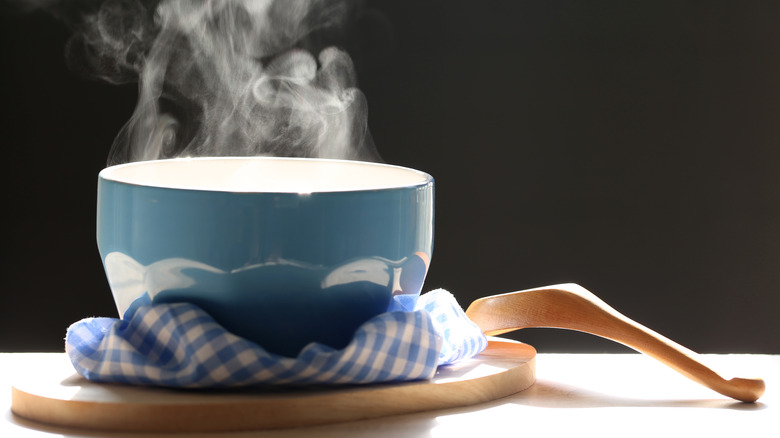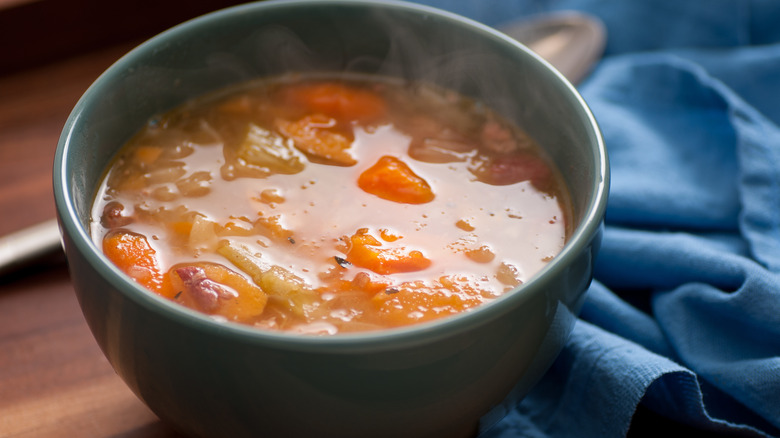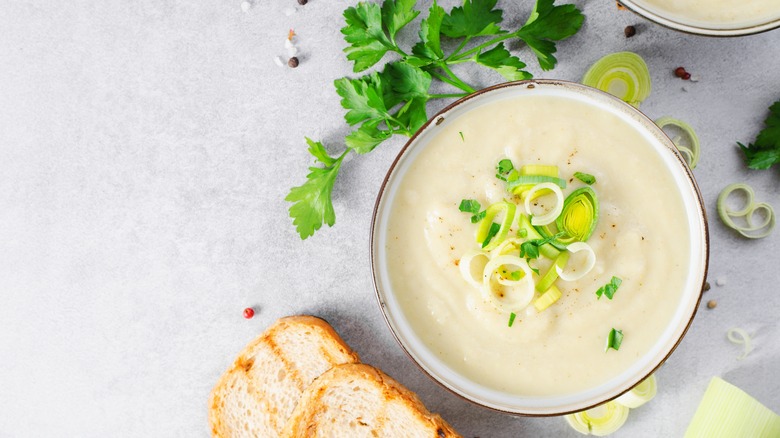Here's Exactly How Hot Soup Can Be Without Burning Your Tongue
On a rainy day or when you have a cold, there's nothing better than a piping-hot bowl of soup, from a basic tomato and herb soup to a simple roasted butternut squash soup. However, how hot is too hot? The last thing you want to do is recreate that infamous McDonald's hot coffee lawsuit with your mouth. Avoid burning your mouth on those chicken noodles or clam chowder by using a food thermometer to gauge how hot your soup is. Your poor tongue will appreciate you taking this precaution rather than gauging the temperature by taking a mouthful.
According to the National Library of Medicine, you shouldn't serve hot liquids (like soup) at a temperature higher than 153 degrees Fahrenheit, which is also the pain threshold for most people. You shouldn't try to soldier your way through a scalding mouthful of soup, as anything above 160 degrees Fahrenheit can result in a burn. So, what temperature should you serve your soup? It really depends upon your preference. If you prefer your soup slightly on the lukewarm side then go for soup that's a little more chilled. However, the ideal temperature is somewhere between 136 degrees Fahrenheit to 149 degrees Fahrenheit.
You shouldn't undercook your soup though. It's recommended that your soup be cooked from 165 degrees Fahrenheit to 212 degrees Fahrenheit to kill any bacteria in the dish. Likewise, you should consider how temperature affects the flavor of your soup.
How temperature affects taste of soup
Temperature doesn't just affect how cooked your food is, it can also affect the flavors of your dish as well. According to a 2017 study in the International Journal of Food Properties, cooking chicken broth increases its umami flavors. Researchers found that longer cook times enhanced the flavors of the broth as well. Likewise, a research paper in the Journal of Sensory Studies showcased that the taste of cheese changed based on the temperature at which it was served.
So, in the case of soup, higher cooking temperatures will enhance the taste of the dish by releasing the natural flavors of its ingredients. However, that doesn't mean you should serve your soup scalding hot — and there are reasons besides just the risk of burns. If your soup is really hot, it can actually have a detrimental effect on the overall taste of the soup. You see, your brain's ability to perceive taste decreases as the temperature of a dish rises. Your brain is trying to warn you that you're in danger of burning yourself, which overrides your brain's ability to register taste. It turns out that the temperature of your tongue also plays a role. So, warming one part of your tongue may trigger an increased taste of saltiness or savoriness.
When it comes to soup, you want to cook it piping hot to release its flavor. However, you will want to cool it before serving.
How to cool down your soup
You've just finished cooking a pot of soup, but it's too hot to handle. Don't accidentally burn your tongue being overeager for your dinner. The simplest way to cool your soup is probably time. Ladle your soup into a bowl and let it cool on the countertop. Alternatively, you can also place it in the fridge to cool as well. If you're a bit impatient to eat, then there are ways that you can cool down your soup more quickly.
If you have cooling paddles on hand, then you can quickly cool down your soup. These kitchenware are lifesavers for anyone wanting to quickly cool down their food. To use a cooling paddle, you'll need to fill them with water and freeze them the night before. So they're not something that you can use at the last minute. From there, use the paddle to stir your soup until it's cool. The advantage to this is that you won't have to remove the soup from the pot.
If you don't have cooling paddles, you can also add ice to your soup. However, you'll have to plan ahead and make a thicker soup to avoid diluting your broth too much. Alternatively, you can also place your pot of soup in an ice bath. Just fill the sink with a bit of water and ice. From there, place your soup in the sink, and the ice will help to cool the liquid.


